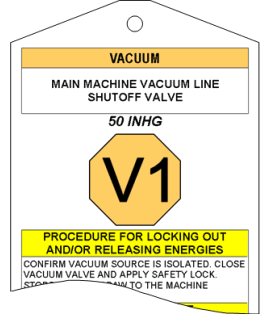Home » Lockout Resources » Energy Source Reference » Other Energy Sources
Other Energy Sources

Definition of Other Hazardous Energy
Certain equipment and/or processes may have an Energy Source that is not addressed by the typical energy source definitions. These unique energy sources may present specific dangers that need to be defined and properly controlled. A few examples are listed below:
- Vacuum: A deep or large volume vacuum draw may require a controlled return to atmosphere.
- Grain: The flow, or potential flow, of grain in large volume breweries or food-processing plants may require specific controls to prevent danger to personnel due to unrestricted movement of material.
- Powder: Lightweight particulates, either a material used in the process or a byproduct of the process, may result in airborne contaminants that present inhalation or combustion hazard.
For these conditions, unique Lockout/Tagout procedures and energy control tags are developed as needed.
Associated Hazardous Energy Hazards
Injuries associated with these unique energy sources will vary depending upon the type of energy. Possible injuries could be:
- Eye injuries due to moving material.
- Burns or suffocation.
- Crushing
Proper Lockout/Tagout can virtually eliminate the risk involved with Hazardous Energy.
Means of Hazardous Energy Isolation
Controls for unique Hazardous Energy sources may be specific for each application, but in many cases the control devices will be similar to those used for other, traditional energy sources.
Verifying Absence of Hazardous Energy
Verifying the absence of unique Hazardous Energy potential after performing Lockout/Tagout will depend on the type of unique energy.
Typical Energy Isolation Devices
Unique Hazardous Energy isolation devices may vary in design and may be specific to the type of Energy Source. In some cases, though, they may be similar to other energy isolation devices such as:
- Gate Valves.
- Ball Valves.
- Butterfly Valves
Typical Energy Lockout Devices
Hazardous Energy Lockout devices use positive means such as a lock and key to keep the associated energy isolation device in the safe position and prevent equipment energization. Typical hazardous energy lockout devices are outlined in the Valve and Pneumatic page.
Lockout Services | Turnkey Programs | Lockout Procedures | Single-Source Procedures | Basic Procedures | Standard Procedures | Advanced Procedures | Custom Procedures | Energy Control Tags | Alternative Protective Measures | Minor Servicing Exception | Online Services | Lockout Audits | Corporate Standards | Lockout Training | Reference Guides | Services RFQ | DEenergizer | Lockout Devices | Electrical | Valve and Pneumatic | Accessories | Group Lockout/Tagout | Devices Index | Devices RFQ | Lockout Resources | OSHA Documentation | NIOSH Documentation | White Papers and Articles | Lockout/Tagout FAQ | Lockout/Tagout News | Lockout/Tagout Signs | Energy Source Reference | Training Material | Library | Glossary | Sitemap | About | Contact Information | Careers | Privacy Policy | Terms of Use | Legal Notice

